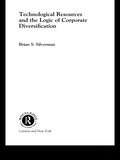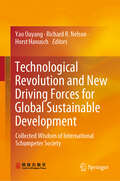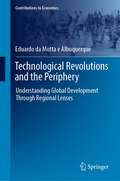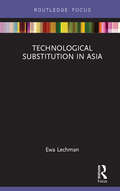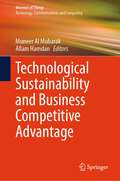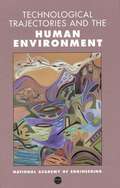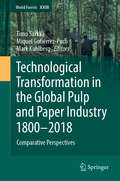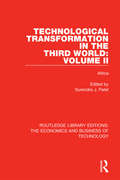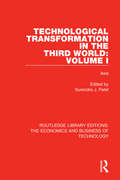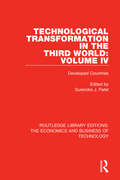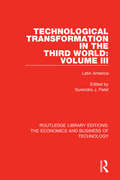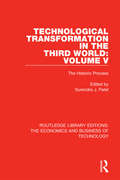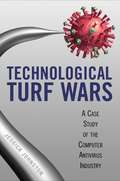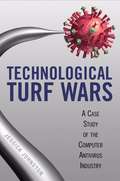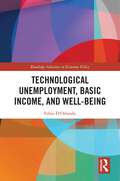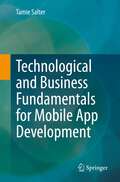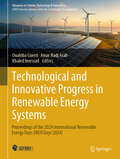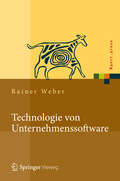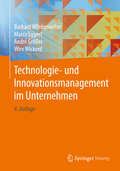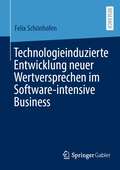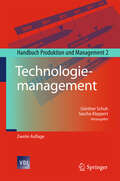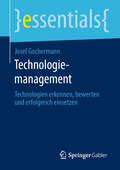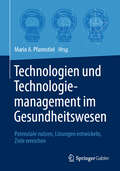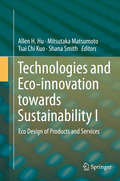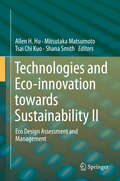- Table View
- List View
Technological Resources and the Logic of Corporate Diversification (Routledge Studies In Global Competition Ser. #Vol. 13)
by Brian S SilvermanThis impressive book sees the author applying and extending the resource based view of the firm to explain and predict the strategy of corporate diversification.Technological Resources and the Logic of Corporate Diversification is an original and authoritative book that will be extremely useful to academics and students in such disciplines as busin
Technological Revolution and New Driving Forces for Global Sustainable Development: Collected Wisdom of International Schumpeter Society
by Yao Ouyang Richard R. Nelson Horst HanuschThis book collects the insights from the researchers of International Schumpeter Society and focuses on the interaction of technology development and global sustainable development. It explores in the following four areas: first, the evolutionary process of economic transformation, the effects of disruptive technological changes, and complexity issues in economics; second, the development trends of contemporary technological transformation, the path of sustainable development driven by technological innovation, and the opportunities and challenges brought by the digital economy; third, technological innovation and industrial upgrading in developing countries, the technological and institutional reasons for leapfrog development in latecomer countries, and the technological innovation driving the accelerated iteration of emerging industries; fourth, the collaborative mechanisms of innovation and entrepreneurship, the role of innovation and entrepreneurial spirit, and the transformation of education and entrepreneurial methods to adapt to the digital economy. Through a comprehensive exploration of these issues, it systematically addresses the significant question of how to seek new impetus for global sustainable development from the perspective of new technological transformation amid a global economic downturn.
Technological Revolutions and the Periphery: Understanding Global Development Through Regional Lenses (Contributions to Economics)
by Eduardo da Motta e AlbuquerqueThis book evaluates the uneven propagation of technological revolutions, investigating the roots of this phenomenon in the absorptive capabilities that are built by countries and regions at the periphery. To understand this global process, this book looks to two dimensions: time and geography. Temporally, the book follows the sequence of technological revolutions in the last 250 years. With regard to geography, the book studies five different regions at the periphery—China, India, Africa, Russia and Latin America—to understand how they differ in the institutional processes that shape their absorptive capabilities. Focusing on each technological revolution and its impact on those five peripheric regions, the chapters illustrate how each region coped with each shock wave emanating from the center. Providing a truly global outlook of a complex system with a dynamic nature, this book will be of interest to researchers and students of development economics, the economics of innovation, evolutionary economics, and the economics of science and technology.
Technological Substitution in Asia (Routledge Frontiers of Business Management)
by Ewa LechmanOver last few decades, the world has witnessed, the process of rapid diffusion of new information and communication technologies (ICT) that enforced remarkable changes and structural shifts going far beyond economic sphere of life. ICT become fast available widespread and rapidly growing access to and use of ICT, additionally enhances the process of technological substitution, which consists in switching from the ‘old’ to ‘new’ technological solutions. The on-going digital revolution, undeniably, pervasively impacts and reshapes societies and economies, hence deserves special attention and interest. This book provides extensive evidence on information and communication technologies development diffusion patterns, unveils specific ‘network effects’ that enhance rapid spread of ICT, and detect major macroeconomic determinants of this process, across 36 Asian economies over the period 1980-2015. Moreover, this research traces country-specific patterns of the unique process. We consider two types of technological substitution, namely: ‘fixed-to-mobile’ type technological substitution process encompasses switching from fixed telephony (‘old technology’) to mobile telephony (‘new technology’); while the ‘fixed-to-wireless’ type technological substitution – switching from fixed (narrowband and/or broadband) fixed Internet networks (‘old technologies’) to wireless (mainly broadband) Internet networks (‘new technologies’). Moreover, this study empirically identifies the potential effect of selected macroeconomic factors, which may potentially enhance dynamic spread of ICT.
Technological Sustainability and Business Competitive Advantage (Internet of Things)
by Allam Hamdan Muneer Al MubarakThis book discusses advanced technological solutions in Industry 5.0 that can be used for business competitive advantage and sustainability. The book presents tools that can help reduce time and make use of data in an efficient way while using resources efficiently and sustainably. The book aims to highlight technological sustainability through promoting innovations, improving social development, and providing green products that benefit the society. The authors discuss the recent technological advancements such as Artificial Intelligence (AI), Internet of Things (IoT), Financial Technology (FinTech), Big Data, and Blockchain. They also discuss the benefits of incorporating such technologies in areas such as green supply chain, storage technology, Internet banking, and nanotechnology. The target audience of this book includes all interested individuals and institutions in the fields of engineering, business, technology, and public services. The book provides insights and solutions to many issues and creates opportunities for further sustainability.
Technological Trajectories and the Human Environment
by Jesse H. Ausubel H. Dale LangfordTechnological Trajectories and the Human Environment provides a surprising projection of a much greener planet, based on long-range analysis of trends in the efficient use of energy, materials, and land.The authors argue that we will decarbonize the global energy system and drastically reduce greenhouse gas emissions. We will dematerialize the economy by leaner manufacturing, better product design, and smart use of materials. We will significantly increase land areas reserved for nature by conducting highly productive and environmentally friendly agriculture on less land than is used today, even as global population doubles.The book concludes that the technological opportunities before us offer the possibility of a vastly superior industrial ecology. Rich in both data and theory, the book offers fresh analyses essential for everyone in the environmental arena concerned with global change, sustainable development, and profitable investments in technology.
Technological Transformation in the Global Pulp and Paper Industry 1800–2018: Comparative Perspectives (World Forests #23)
by Mark Kuhlberg Timo Särkkä Miquel Gutiérrez-PochThis contributed volume provides 11 illustrative case studies of technological transformation in the global pulp and paper industry from the inception of mechanical papermaking in early nineteenth century Europe until its recent developments in today’s business environment with rapidly changing market dynamics and consumer behaviour. It deals with the relationships between technology transfer, technology leadership, raw material dependence, and product variety on a global scale. The study itemises the main drivers in technology transfer that affected this process, including the availability of technology, knowledge, investments and raw materials on the one hand, and demand characteristics on the other hand, within regional, national and transnational organisational frameworks.The volume is intended as a basic introduction to the history of papermaking technology, and it is aimed at students and teachers as course material and as a handbook for professionals working in either industry, research centres or universities. It caters to graduate audiences in forestry, business, technical sciences, and history.
Technological Transformation in the Third World: Africa (Routledge Library Editions: The Economics and Business of Technology #36)
by Surendra J. PatelOriginally published in 1993, this book contains 3 studies on Africa: Algeria, Tanzania and Zimbabwe. The studies underline the difficulties which Africa has faced in initiating its technological transformation. During the post WW2 period liberation from colonialism came relatively late and therefore many African countries did not have the possibility of participating in the rapid growth of global output and trade. Debt, drought and famine have put additional burdens on the economic conditions of the continet. Adverse conditions and poor infrastructure have made the continent much more vulnerable to both external and internal disturbances and as a result many countries have not had the opportunity to make a real beginning towards their transformation.
Technological Transformation in the Third World: Asia (Routledge Library Editions: The Economics and Business of Technology #35)
by Surendra J. PatelOriginally published in 1993, this book contains 4 studies on Asia: Bangladesh, India, South Korea and Sri Lanka. The studies reflect 4 different patterns of technological transformation. India, with its large populaiton has made considerable progress but its overall development has been slow until recently. At the other extreme, South Korea which had a very low per capita income in the 1950s registered a quantum leap in technological transformation within a short span of 30 years. The heritage of Bangladesh's past has constrained its progress in overcoming structural weaknesses but in comparison, Sri Lanka displays a very different pattern. The sources used draw upon research in development economics, economic history, technology and studies in general and country studies in particular.
Technological Transformation in the Third World: Developed Countries (Routledge Library Editions: The Economics and Business of Technology #38)
by Surendra J. PatelOriginally published in 1993, this book contains 3 studies from Finland, Greece and Japan. These countries were chosen because they experienced their technological transformation mainly during the 20th Century and it was considered that their experience would have some relevant lessons for the countries of the third world. Special attention is paid to Japan as its example has great relevance both for development theory and practical strategies.
Technological Transformation in the Third World: Latin America (Routledge Library Editions: The Economics and Business of Technology #37)
by Surendra J. PatelOriginally published in 1993, this book contains 3 studies from Latin America: Mexico, Puerto Rico and Venezuela. These studies bring out sharply the processes at work in Latin America between 1950 and 1980, which were responsible for the crisis that the continent faced in the 1980s. In each case there was a striking failure in building up national technological capability so that the country could grapple with the problems it faced.
Technological Transformation in the Third World: The Historic Process (Routledge Library Editions: The Economics and Business of Technology #39)
by Surendra J. PatelOriginally published in 1995, this book follows the preceding 4 volumes (Aisa, Africa, Latin America and Developed Countries) and discusses technological transformation in development history. It looks back on two centuries of history of the emergence of developed countries and examines the various aspects determining the speed, size and shape of the historical process of transformation in developed countries after World War 2.
Technological Turf Wars: A Case Study of the Computer Antivirus Industry
by Jessica JohnstonInTechnological Turf Wars, Jessica Johnston analyzes the tensions and political dilemmas that coexist in the interrelationship among science, technology and society. Illustrating how computer security is as concerned with social relationships as it is with technology, Johnston provides an illuminating ethnography that considers corporate culture and the workplace environment of the antivirus industry. Using a qualitative, interdisciplinary approach, which combines organizational and security studies with critical and social analysis of science and technology, Johnston questions the motivations, contradictions and negotiations of antivirus professionals. She examines the tensions between the service ethics and profit motives-does the industry release viruses to generate demand for antivirus software?-and considers the dynamics within companies by looking at facets such as gender bias and power politics. Technological Turf Warsis an informed, enlightened and entertaining view of how the production of computer security technology is fraught with social issues.
Technological Turf Wars: A Case Study of the Computer Antivirus Industry
by Jessica R. JohnstonIllustrating how computer security is as concerned with social relationships as it is with technology, Johnston provides an illuminating ethnography that considers corporate culture and the workplace environment of the antivirus industry. Using a qualitative, interdisciplinary approach, which combines organizational and security studies with critical and social analysis of science and technology, Johnston questions the motivations, contradictions and negotiations of antivirus professionals. She examines the tensions between the service ethics and profit motives--does the industry release viruses to generate demand for antivirus software?--and considers the dynamics within companies by looking at facets such as gender bias and power politics. Technological Turf Wars is an informed, enlightened and entertaining view of how the production of computer security technology is fraught with social issues.
Technological Unemployment, Basic income, and Well-being (Routledge Advances in Economic Policy)
by Fabio D'OrlandoThe main novelty of the Fourth Industrial Revolution is the entry of robots and Artificial Intelligence into the production process. This phenomenon could potentially generate high levels of unemployment, or even full unemployment, and therefore calls for innovative public policies. This book adopts an agnostic position on the size of the future impact of technological progress on employment but proposes a thought experiment built on a full unemployment scenario, which focuses on the consequences that these policies might have for people’s well-being, with particular reference to the provision of a universal Basic Income (UBI). Relying on some of the principles and models of Behavioral and Happiness Economics, it is argued that implementing a UBI that does not change over time may increase well-being inequality. A policy mix that combines a rising basic income with other measures is therefore recommended. This book marks a significant contribution to the literature on economic policy, labor economics, the economics of well-being and happiness, and behavioral economics.
Technological and Business Fundamentals for Mobile App Development
by Tamie SalterThis book is an essential introductory guide to the knowledge required to develop apps. Chapter by chapter it provides the core principles any person must understand in order to develop mobile applications. It outlines the fundamental skills and knowledge that business and computer science students need to either oversee the development of a mobile app or themselves undertake to develop a mobile app. This workbook will give a holistic overview of the initial stages that must be considered when endeavoring to develop a mobile app. This workbook breaks topics down into core, technical and non-technical. Looking at each topic from all three angles, the core knowledge required for UI, UI for the technical person and UI for the non-technical person. The workbook guides the student through the key components or core of mobile app development and shows all students both the technical requirements and the non-technical requirements of each topic. It will allow all students to pick and choose how deep they wish to delve into the different topics.
Technological and Innovative Progress in Renewable Energy Systems: Proceedings of the 2024 International Renewable Energy Days (IREN Days'2024). (Advances in Science, Technology & Innovation)
by Ouahiba Guerri Amar Hadj Arab Khaled ImessadThis book is the proceedings of the papers presented during the International Renewable Energy Days on May 28–30, 2024, in Algiers (IrenDays’2024). It provides a comprehensive and current overview in the field of renewable energies and their role in promoting a sustainable world. Whether solar, wind, hydrogen, biomass or bioenergy, this book covers a wide range of topics including resource assessment and forecasting, energy conversion and efficiency, renewable grid integration, innovative technologies and new materials, energy efficiency in buildings, energy storage, sustainable hydrogen, alternative fuels, desalination and water treatment, as well as energy policy and economic aspects of renewable energy. Including the latest research studies on renewable energy, this book presents a review of recent developments in renewable energy systems and their applications, along with the challenges to their widespread use. Furthermore, this book includes suggestions resulting from discussions at roundtables on “Innovation in Renewable Energy: Strategy and Standards” and “Artificial Intelligence for Renewable Energy Systems.” This book is aimed at researchers, scientists and postgraduate students as it provides an in-depth overview of the most recent advances in the field of renewable energy and sustainable development. It could serve as a guide for industrialists and policy makers in emerging countries, as it provides best practices in the renewable energy sector and suggests the development of a renewable energy strategy. This book not only informs but also can contribute to a greener planet and a sustainability-oriented future.
Technologie von Unternehmenssoftware
by Rainer WeberUnternehmenssoftware - das sind operative Anwendungssysteme, analytische Systeme wie Data-Warehouse-Systeme und Planungssysteme, z. B. für das Supply-Chain-Management. In dem Buch werden die zugrunde liegende Technologie und die Modellierungskonzepte beschrieben. Behandelt werden auch Integrationstechniken zur Verbindung mehrerer Systeme, Methoden im Lebenszyklus von Unternehmenssoftware sowie Client-Server-Technologie und Geschäftsobjekte, aber auch neue Entwicklungen wie Cloud-Computing. Mit vielen Beispielen und Übungen mit Lösungsvorschlägen.
Technologie- und Innovationsmanagement im Unternehmen: Lean Innovation (Vdi-buch Ser.)
by Marco Eggert Burkard Wördenweber André GrößerDer globale Wettbewerb verändert das Umfeld, in dem Firmen agieren. Um nicht an den Rand gedrängt zu werden, sind Unternehmen gezwungen, sich selbst zu erneuern, indem sie kontinuierlich Prozesse verbessern, Produkte mit Mehrwert entwickeln und Kundenwünsche aufspüren. Die Autoren beschreiben in der 3. Auflage anhand sechs neuer Themen weitere Methoden zur Gestaltung dieses Erneuerungsprozesses. Der Praxisleitfaden enthält schnell umsetzbare Praxistipps und nützliche Software-Tools für ein erfolgreiches Innovations- und Technologiemanagement.
Technologieinduzierte Entwicklung neuer Wertversprechen im Software-intensive Business
by Felix SchönhofenDie Digitalisierung der meisten Branchen spiegelt sich in einem wachsenden Anteil der Software an der Gesamtwertschöpfung wider. Unternehmen eröffnen sich dadurch neue Möglichkeiten für technologische Innovationen. Gleichzeitig stehen sie aber vor der ständigen Herausforderung, diese Innovationen in Produkte zu überführen, die für den Kunden wertstiftend sind. Dieser Problemstellung widmeten sich bereits eine Reihe an Methoden zur Produkt- und Geschäftsmodellinnovation, die Überführung der hier gewonnenen Erkenntnisse in die konkrete Produktgestaltung bleibt jedoch eine Herausforderung.Genau hier setzt diese Arbeit an, indem sie die methodische Vorgehensweise „Value Proposition Deployment“ vorschlägt, mit der Unternehmen auf Basis technologischer Innovationen neue Wertversprechen entwickeln können. Hierzu verbindet das Value Proposition Deployment Erkenntnisse des Innovationsmanagements mit Methoden der konstruktiven Qualitätssicherung und stellt somit eine Brücke zwischen Innovations- und Qualitätsmanagement dar. Die auf Basis von 15 praxisrelevanten Gestaltungsanforderungen entwickelte Methode wird detailliert erläutert und anhand praxisnaher Fallbeispiele beschrieben.
Technologiemanagement
by Günther Schuh Sascha KlappertDer 2. Band der Buchreihe "Produktion und Management" konzentriert sich auf den Umgang mit Technologien. Die Autoren nehmen Technologiestrategien zum Ausgangspunkt und führen in die grundlegenden Zusammenhänge, Vorgehensweisen und Methoden des Technologiemanagements ein: von der Technologiefrüherkennung über die Technologieplanung, Technologieentwicklung und Technologieverwertung bis zur Technologiebewertung. Leser können sich einen Überblick zum Thema Technologiemanagement verschaffen und den Stoff anhand realer Fallbeispiele nachvollziehen.
Technologiemanagement: Technologien erkennen, bewerten und erfolgreich einsetzen (essentials)
by Josef GochermannJosef Gochermann liefert in diesem essential ein Kompendium über die wesentlichen Elemente des Technologiemanagements und gibt Antworten auf zehn wichtige Fragen, wie Sie neue Technologien identifizieren, relevante Technologien richtig bewerten, Chancen und Risiken rechtzeitig erkennen und sich technologisch erfolgreich aufstellen können. Er zeigt, wie Technologien nutzbringend eingesetzt werden, relevante Technologien zum richtigen Zeitpunkt zur Verfügung stehen, das Ende der Leistungsfähigkeit einer Technologie rechtzeitig erkannt werden und der Einsatz von Technologien strategisch und für die Zukunft geplant werden können.
Technologien und Technologiemanagement im Gesundheitswesen: Potenziale nutzen, Lösungen entwickeln, Ziele erreichen
by Mario A. PfannstielTechnologien tragen erheblich zur Verbesserung der Patientenversorgung im Gesundheitswesen bei. Um das in ihnen liegende Potenzial zu heben und sicherzustellen, dass die richtigen Technologien zum Einsatz kommen, ist eine umfassende Herangehensweise notwendig. Diese beginnt mit einer gründlichen Analyse und Bewertung der verfügbaren Technologien für den jeweiligen Einsatzbereich. Das Technologiemanagement übernimmt im Anschluss die Schlüsselrolle bei der effizienten Einführung neuer Technologien, einschließlich strukturierter Implementierung, Kostenkontrolle und der Gewährleistung von Sicherheit und Datenschutz. Auf diese Weise wird sichergestellt, dass Technologien reibungslos in bestehende Strukturen integriert werden, die Effizienz im Gesundheitswesen steigt und die Qualität der Patientenversorgung erheblich verbessert wird. Das vorliegende Herausgeberwerk gibt einen Überblick zu den aktuellen Themen aus Theorie und Praxis des Technologiemanagements im Gesundheitswesen und umfasst auch Fragen zum Einsatz von künstlicher Intelligenz. In 44 Beiträgen teilen 92 renommierte Autoren ihre umfangreiche Expertise, wertvollen Erkenntnisse, Erfahrungen und vielfältigen Perspektiven und geben konkrete Hinweise für die Praxis. Das Buch zeichnet sich durch eine klare Strukturierung und Einordnung der Buchbeiträge in den technologischen Gesamtkontext aus, wodurch es gleichermaßen für Einsteiger als auch für Praktiker und Wissenschaftler von großem Nutzen ist.
Technologies and Eco-innovation towards Sustainability I: Eco Design of Products and Services
by Mitsutaka Matsumoto Allen H. Hu Tsai Chi Kuo Shana SmithThis 2-volume book covers the state-of-the-art of the research and practices on eco-design. It covers the latest topics in the field: e.g. global eco-design management, big data in eco-design, social perspectives in eco-design; as well as emphasizing the developments in emerging economies such as Asian countries. Eco-design of products and product-related services are indispensable to realize the circular economy and to increase resource efficiencies of our society. Eco-design practices are necessary both in developed countries and developing countries. The book chapters are contributed by the worldwide authors, especially authors from East Asian countries, European countries, and Southeast Asian countries, and contains selected presentations at the EcoDesign2017 symposium (10th International Symposium on Environmentally Conscious Design and Inverse Manufacturing). The first volume highlights products and services, the chapters include the product life cycle design and business strategy, technologies for the future and sustainability, as well as social perspectives in eco-design.
Technologies and Eco-innovation towards Sustainability II: Eco Design Assessment and Management
by Mitsutaka Matsumoto Allen H. Hu Tsai Chi Kuo Shana SmithThis 2-volume book covers the state-of-the-art of the research and practices on eco-design. It covers the latest topics in the field: e.g. global eco-design management, big data in eco-design, social perspectives in eco-design; as well as emphasizing the developments in emerging economies such as Asian countries. Eco-design of products and product-related services are indispensable to realize the circular economy and to increase resource efficiencies of our society. Eco-design practices are necessary both in developed countries and developing countries. The book chapters are contributed by the worldwide authors, especially authors from East Asian countries, European countries, and Southeast Asian countries, and contains selected presentations at the EcoDesign2017 symposium (10th International Symposium on Environmentally Conscious Design and Inverse Manufacturing).The second volume focus on assessment and management, including topics such as sustainable manufacturing and End of Life (EOL) management, sustainability assessment, policy and regulations and Incentives for eco-design.
